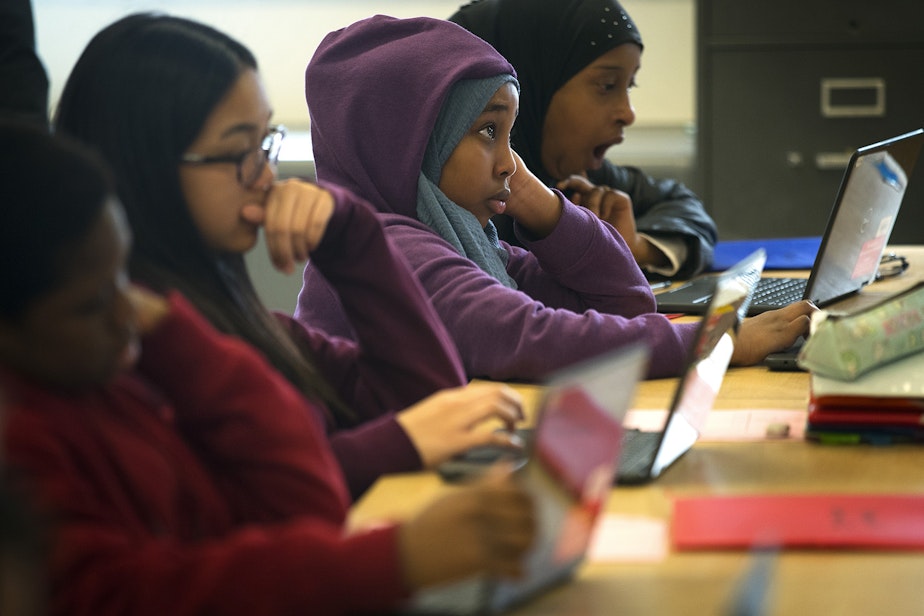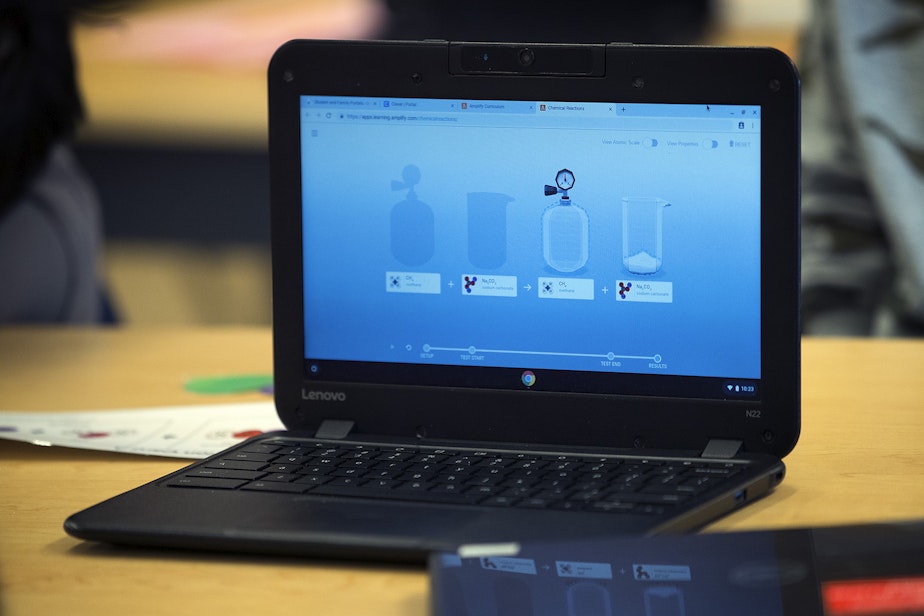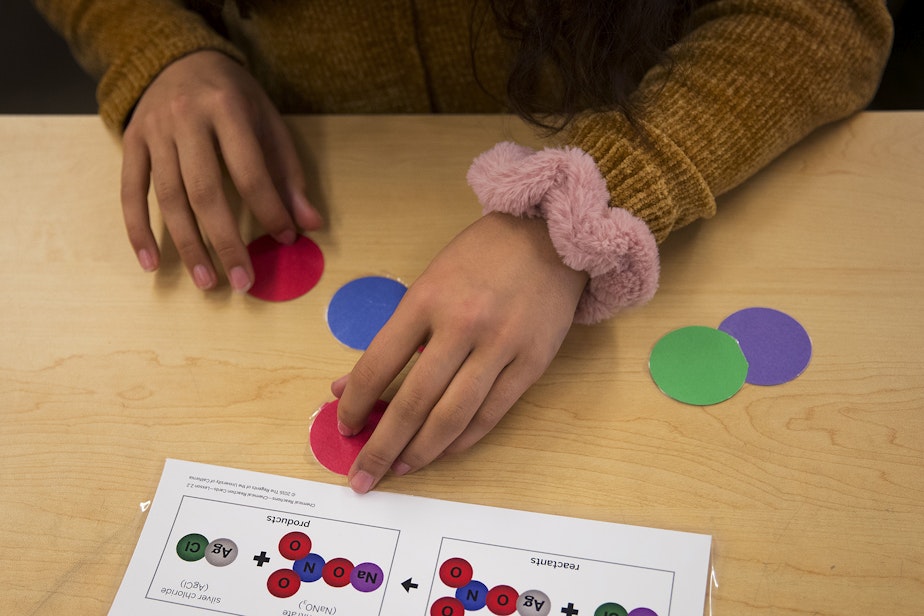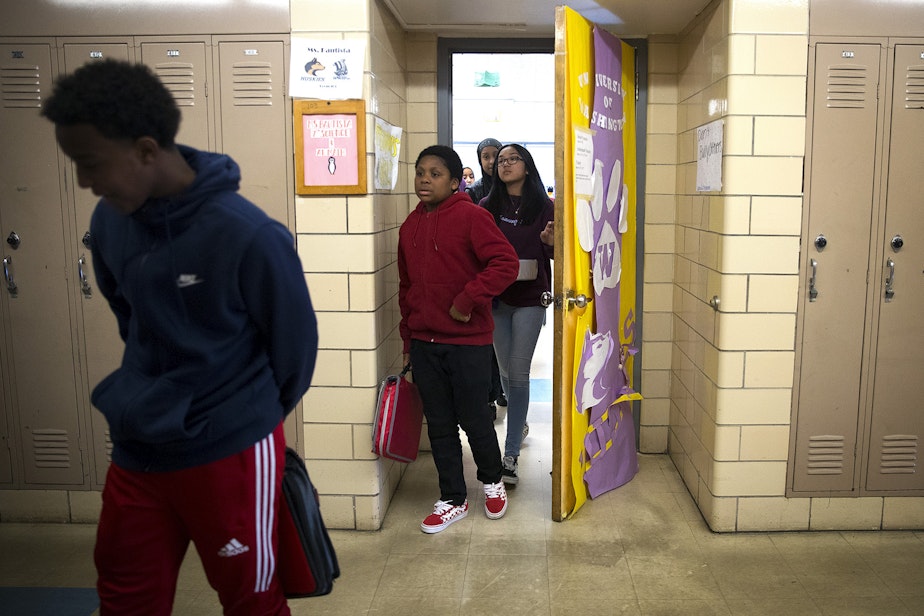'A shady mess': Seattle Schools debates proposed science curriculum

S
imon Harrington, a 7th grader at Jane Addams Middle School in Seattle, loves science — just not the new science curriculum his school introduced last year.
"We sat down at computers, watched the video, and for the rest of the day did a lesson," he said. "We were basically bored by it."
Michael Lemon, a science teacher at Whitman Middle School, used the same new curriculum. He said he felt like a clerk in a grocery self-checkout line, staring at his computer to monitor how his students entered answers on their own screens.
“It takes the human factor out of it, and it makes it very clinical," Lemon said.
How this tech-driven curriculum, Amplify Science, ended up in their schools, and at least 18 others, is not entirely clear. Despite mixed reviews from students and teachers, it's now the front-runner to become the district’s official science curriculum for elementary and middle schools.
The district says new K-12 science curricula are critical to meet state standards, and for students to do well on the new state science test.
Sponsored
Proponents of Amplify Science say it’s an equalizer that will ensure students have the same high-quality materials, no matter their school, or quality of their science teacher.
Sponsored
Detractors say it’s a new, untested curriculum that relies too much on screens, rather than traditional hands-on labs and student-teacher interaction, and kills students’ interest in science.
If the school board approves Amplify Science, it could be how tens of thousands of Seattle children learn science for the next nine years.
C
urriculum publishing is big business: Several years ago, when Amplify was owned by News Corp., Rupert Murdoch sank $1 billion into the company before losing hundreds of millions on digital curricula and tablets for schools. News Corp. then sold the ed-tech company to Emerson Collective, a philanthropy owned by Laurene Powell Jobs, the widow of Apple founder Steve Jobs.
The price tag for Amplify’s elementary and middle school science curricula in Seattle, including teacher training, is $8.9 million for nine years. Now questions have arisen about how Amplify Science came to the district, and whether the process violated both district policy and state laws.
Sponsored

The school board is supposed to approve large-scale curriculum adoptions. Instead of seeking board approval, however, in 2017 the 20 schools each applied for special permission to use Amplify through curriculum waivers — a mechanism typically reserved for individual schools, like language immersion programs, to get permission to use their own choice of curriculum.
Sue Peters, who was on the school board at the time, said the board was unaware of the science waivers for months, and that board members were none too pleased when they learned of the workaround. “Waivers are not intended to be used en masse and orchestrated by the central office in order to field test a product,” Peters said. “Staff used the policy to essentially implement a de facto curriculum adoption without the Board’s knowledge or approval. That is a violation of policy and state law.”
According to board meeting minutes, district staff explained to the board that waivers were needed to take advantage of a grant opportunity for the district to pilot Amplify Science. That grant is at the center of much of the controversy: the district cannot say who funded it, or even its cash value. That murkiness has led to questions from the school board and the public about whether Amplify sought — and received — an unfair advantage to become the district’s next K-8 science curriculum.
How Amplify came to be implemented in those 20 schools matters: The district cannot legally let gifts or grants from vendors determine what, and how, students are taught — nor be seen as allowing a vendor to gift its way into favor.
Sponsored
The grant came after an anonymous benefactor donated money to Amplify earmarked for Seattle Public Schools, said district spokesman Tim Robinson by email. He said the mystery donation paid for Amplify Science for 20 schools. “Our understanding was it was $100,000,” Robinson said.
The actual amount of that grant is important, because the district is required to determine the value of all gifts and grants, and must bring those worth at least $250,000 before the board.
Peters, the former school board member, suspects the grant from Amplify was actually worth at least that amount. In its bid for the official district middle school contract, the company’s most recent quote came to $204,141 per year. But district policy requires any additional costs — like the laptops needed to run the curriculum at the 20 schools — to be factored into the total amount.
Also confusing is the series of events that led up to the grant. KUOW asked the district to clarify the timeline, and received conflicting information.
Sponsored
How did the donation come about?
MaryMargaret Welch, the district’s science program manager, told the board the mysterious donation to Amplify came after she was overheard at a conference lamenting the district’s inability to afford a new science curriculum. This account comes from three people who attended the board meeting.
In an interview with KUOW, however, Welch said she had told Amplify that the district had approved the waivers, but couldn’t afford the curriculum, and the company said it would look for a donor.
“The science curriculum adoption process has proceeded entirely properly,” said Robinson, by email. “There has never been a circumstance of inappropriate actions on the part of any SPS employee regarding any science curriculum.”
District staff defended the unorthodox approach of implementing 20 waivers for a new curriculum, rather than waiting for board approval. “There wasn’t a curriculum adoption on the horizon, and schools needed current, relevant curriculum for students,” wrote Carri Campbell, another Seattle Schools spokesperson, by email.

W
elch has overseen the curriculum selection process over the last year. The veteran teacher heads three science adoption committees — elementary, middle and high school — of about 90 educators and community members. They were charged with narrowing down the options through an elaborate series of evaluations and field tests.
The elementary and middle school curriculum finalists included materials from publishers Houghton Mifflin Harcourt and Teachers’ Curriculum Institute. But Amplify ranked much higher in the committees’ evaluations — and, the committees reported, outperformed the other options on the field tests. Ultimately, the school board will decide whether to accept the committees’ recommendations.
Welch said it’s been 26 years since the district overhauled its middle school science curriculum — and that it’s time Seattle brought science, and how it’s taught, up-to-date for students, and in line with the Next Generation Science Standards the state adopted in 2013.
“In the past, a lot of science has been memorization of facts and vocabulary,” Welch said. "We want them to be engaged in conversations around evidence, and using evidence to draw their conclusions."
In looking for new K-12 science curricula, the district looked for products that include hands-on and digital components.
While some parents and teachers are worried about the amount of screen time kids get, Welch said digital platforms allow realistic simulations of things like molecular activity and climate change.
"It gives kids a chance to really interact with digital tools in a very respectful way, but a real, authentic way, that says these digital tools are really important for your learning,” Welch said, adding that professional scientists rely on computers to record and analyze data.
“What we really want to do is to give our kids, especially our kids who don't have digital tools at home, a chance every day to use those kinds of tools,” Welch said, “so they'll be much, much more successful when they take the [state] examination.” The new test is taken on computers.
E
quity is a key issue in the search for new K-12 science curricula: Low-income students, black and Latino children, and English language learners tend to do far worse on science assessments than well-off white students.
Whether Amplify Science provides strong learning outcomes for students is debatable. Despite at least 20 Seattle schools having used the curriculum for a year or more, the district declined to point to any specific gains students who used Amplify last school year achieved over their peers at schools using the standard curriculum.
“It would be premature to respond to the effectiveness of any curricula and inappropriate in the middle of an adoption process,” district spokesman Robinson wrote in an email.
Premature, he said, because the district switched standardized science tests in 2018, from the Measurement of Student Progress to the Washington Comprehensive Assessment of Science, which covers different learning standards and question types, and is administered on computers.

F
ormer school board member Peters said it’s difficult to compare results the first year of a new test: Pass rates dropped across the board in 2018 when it was introduced. But her analysis shows pass rates dropped the most at the Seattle schools using Amplify Science — despite the curriculum’s promise to help students meet the new standards.
“The students that fared the worst were low-income students using Amplify Science,” Peters wrote in an email to the board.
Welch critiqued Peters’ data analysis, and said the first year of a new test was no time to measure curriculum effectiveness.
Amplify, meanwhile, calls characterizations that its science curriculum is untested “inaccurate.” Amplify Chief Marketing Officer Kay Moffett told KUOW in an email that “one million students in districts across the country are using the curriculum."
"Prior to its release, it was field-tested in 150 schools by more than 400 teachers and 10,000 students over three and a half years," Moffett wrote. "The research base that animates this curriculum is the culmination of 20 years of science education research and practice at the Lawrence Hall of Science in Berkeley.”
Seattle School Board President Leslie Harris said she knows a lot of work has gone into the curriculum evaluation process, but she wants to know more about how students did using Amplify before she votes to approve it.
“I would very much like to see the results of the pilot programs,” she said at a board curriculum committee meeting last week. “I want to get more transparent information before I make that decision.”
Board Vice President Rick Burke said he’s eager for high-quality science instruction: He studied mechanical engineering, and runs a company that engineers temperature-sensitive manikins.
“I have not been given evidence that tells me [Amplify] is going to get us where we want it to go,” he said. “I’m just wary about investing ten million dollars, stepping back, and watching.”
A
nother criticism of the curriculum adoption process has been the appearance of conflict of interest by those involved with the adoption committees.
Welch was quoted multiple times in corporate marketing materials for Amplify Science, leading some to question the nature of her relationship with the company:
“‘You can’t have quality education without quality products,’ says MaryMargaret Welch of Seattle Public Schools, adding that today, there’s a certain quality that only digital-forward products, like Amplify’s, can provide,” reads one quote attributed to Welch in the promotional materials.
The school district defended the marketing white paper as “a scholarly article,” and said Amplify was quoting from a presentation Welch gave at a science teachers’ conference.
Welch said she does not have a business relationship with any curriculum publisher. But some parents and community members told KUOW that whatever her relationship to Amplify, it looks like a conflict of interest.
Welch said she sought guidance from the district legal counsel.
"When it was brought to my attention that there might be a perception of conflict of interest, I actually spoke to the attorney, and I got his ruling about that," Welch said.
A
side from Amplify, Welch, and earlier, her predecessor, took part in grant-funded research involving Carbon TIME, a curriculum created by Michigan State University that was among the materials the high school adoption committee considered.
The district also produced its own high school curricula for possible adoption. Some of the teachers who sit on the curriculum adoption committees helped develop those materials.
"We actually had them all sign a document, me included, that we would be sure to be as careful as we could and would show no conflict," Welch said.
She recused herself from voting on the materials, as did four teachers involved with a high school chemistry curriculum, and two who worked on a high school biology curriculum.
“There has been no collusion with Amplify Science,” Welch said.

P
eters, the former school board member, calls the situation "a shady mess."
“It seems like our students are being used as guinea pigs for some of these products,” she said.
"Why was an orchestrated effort made to bring it into the school district?” Peters asked. “Why is the person overseeing it helping to promote it? Who [funded] the grant that initially started this whole thing?”
Lingering questions like those have delayed the curriculum adoption process. At last week’s school board curriculum committee meeting, members were scheduled to vote on moving the proposed curricula to a full board vote.
Instead, the majority of the board members said they still had too many questions to endorse Amplify Science. They voted to involve the entire board in hashing out the remaining questions. On Tuesday the board will discuss whether to put the proposed K-12 curricula up for a vote in May.
Burke, the board vice-president, said they still haven’t gotten the evidence they need that shows Amplify worked as promised in the schools that have used it.
"We have to make sure that our processes are objective, and we have to make sure that they’re free from any type of bias," Burke said.
"There are a lot of people and organizations out there that may be in the business of educating kids,” Burke said. "But they’re in the business.”
Correction 4/29/2019: An earlier version of this story misstated MaryMargaret Welch's involvement with Amplify Science. She did not help develop the curriculum.
Editor's note 5/8/2019: This story has been updated to include a statement from Amplify.




